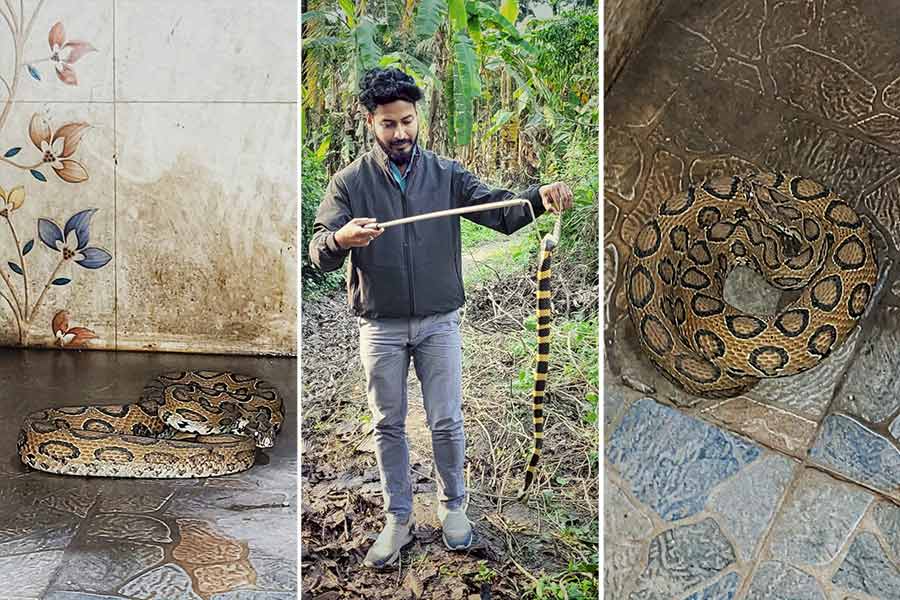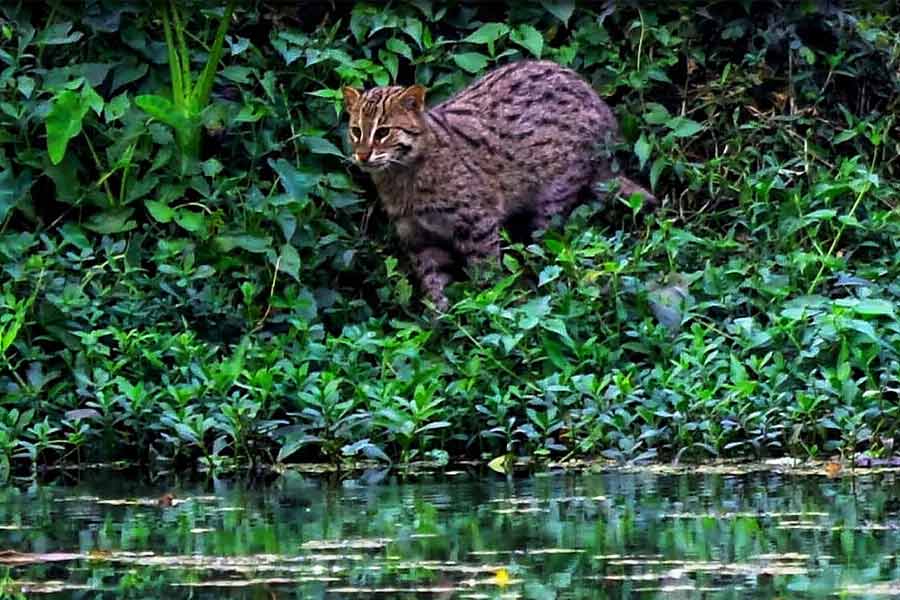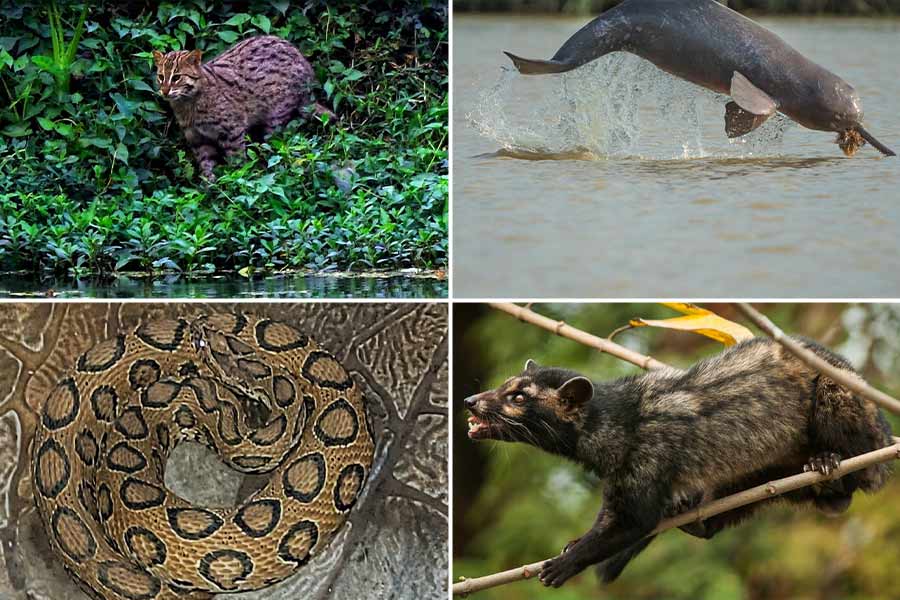A city is no place for wildlife, one might think, but cities have long been places of encounters between humans and wild animals. London has its foxes, Berlin its wild boars, Delhi peafowl and nilgais, and Mumbai leopards. Kolkata, too, has its own biodiversity. The slender shape that slinks through the undergrowth is no rat but the Indian mongoose. Ride by the walls of the Tollygunge Club in the evening and you can hear the calls of its resident jackals. Flying foxes and pipistrelles swarm the evening sky, and for a glimpse of birds both endemic and migratory, one can drop into Rabindra Sarobar or the Indian Botanic Garden.
Gangetic dolphin

A Gangetic dolphin spotted at Katwa in Purba Bardhaman district of West Bengal. It is endangered and protected under the Schedule 1 of the Wildlife Protection Act, 1972
Ripan BiswasAnother animal populates the Hooghly, though rarely spotted because of the turbid waters of its habitat. The Ganges river dolphin or the shushuk, as it is known in Bangla, can only be seen when they breach for air. According to naturalist and wildlife documentary filmmaker Ashwika Kapur, they are “out of sight and therefore out of mind”. I, myself, was unaware of its presence until I spotted one on a boat ride off Prinsep Ghat no. 2 five years ago. The Ganges river dolphin is a chubby creature with a long snout that makes it look more avian than cetacean. When I reported it back to my immediate circle, I met with incredulity. A relative even claimed that a shushuk is different from a dolphin and that I must not have spotted the former, a creature that lays eggs and breathes through gills, rarely breaches, and is more elusive.
Suvrajyoti Chatterjee, secretary of Human and Environment Alliance League (HEAL), a non-profit that works towards the conservation of biodiversity, tells me it’s the kaamot or the bull shark my relative may have had in mind.
The Gangetic dolphin is endangered and protected under the Schedule 1 of the Wildlife Protection Act, 1972. Misconceptions such as my relative’s do not necessarily impede conservation, but they certainly do not contribute to conservation-led action. This presents a difficult job for conservationists: how does one create awareness about an animal that is almost mythical? Chances are the general public has even foggier notions of the dangers these life forms face and so are not able to bring about meaningful environmental change.
Pollution, both industrial and domestic wastewater, has overwhelmed the river system. This, along with the heavy silt in the Ganges, makes the water murky and has, over time, rendered the dolphin blind. By using their highly sophisticated sonar, the dolphins are able to echolocate, but their movement is encumbered by traffic – steamers, barges, ferries, etc. Although a reduction in human activities during the Covid pandemic drew more dolphins to the city ghats, experts are certain that it has not boosted dolphin population in the long run. After the lockdowns ended, the number of ferries were increased, and industries opened up with an aim to compensate for the lockdown lull, driving the dolphins away.
Poachers account for dolphin deaths even though dolphin killing is punishable by law. Dolphin oil is said to be a remedy for arthritis, and it is also used to bait catfish. Dolphins get caught in fishing nets by accident; they either die of wounds caused by entanglement or are beaten to death to preserve the costly nets. Chatterjee of HEAL identifies a domino effect at play: “Sand mining on the banks of the Ganga not only causes damage to the environment, precipitating floods, but also takes away entire generations of fish hatchlings. Due to a depletion in their prey base, dolphins are driven to hunger and desperation, and they often swim deliberately into nets to catch fish.”
While the official dolphin numbers in West Bengal, according to the forest department, stands at approximately 1,000, Chatterjee proposes a more conservative figure in the ballpark of 500. The future holds little by way of hope, it seems, for the Ganges dolphin. The tide, though, has started to change, as it were, in certain parts of the country. Bihar has made admirable progress in dolphin conservation with the establishment of the Vikramshila Dolphin Sanctuary. Non-government organisations in Assam have been working towards the wellbeing of the dolphins in the Kulsi river. It is time for West Bengal and Kolkata to step up. Kolkata can follow Bihar’s example and place boards along the ghats to create awareness about the aquatic mammal. It would encourage people to stop littering and pave the way for more concrete steps to protect the creature that was dubbed the national aquatic animal of India in 2009. Chatterjee suggests that the citizens of Kolkata can support and even join NGOs which travel to rural areas and fishing villages to create awareness.
Common palm civet

HEAL gets up to a dozen calls a month from irate Kolkatans, requesting them to “rescue” – in other words, take away and relocate – common palm civets at large
Amitava MajumderAnother member of the city’s wildlife inhabits spaces more intimate to us but is seldom seen. Nocturnal and extremely shy, the common palm civet is one of the three kinds of civets endemic to the Kolkata metropolitan area. The other two, the small and the large Indian civet, have seen the last of their days in the city. Known locally as the bhaam, palm civets prefer to nest in trees and old, abandoned houses. Soumya Ray, secretary of Prakriti Samsad, a Kolkata-based organisation, dedicated to the study of nature, says: “In the last few years, the fate of civets has become enmeshed with the aspirational desires of the city. An uptick in redevelopment in south Kolkata, especially in Ballygunge, Jadavpur, Tollygunge, and Garia, has seen old bungalows – usually uninhabited or sparsely populated – being replaced with apartment blocks. It has been rendering civets homeless, pushing them into the more densely populated condominiums, increasing confrontations with humans.”
HEAL gets up to a dozen calls a month from irate Kolkatans, requesting them to “rescue” – in other words, take away and relocate – civets at large. Citizens are, on the whole, hostile towards these animals, and much has to do with the perception that they are pests, “thieves”. Our emotional responses to animals are also governed by their appearances. Dolphins are perceived to be cute, lovable creatures, and the same goes for dogs and cats; their physiological features generate a nurturing instinct in humans. Civets, on the other hand, with their scruffy coat and bulbous eyes are “not considered to be good looking, and perhaps even repulsive to the human eye,” says Kaushik Deuti, a scientist at the Zoological Survey of India. “It is compounded by the general conviction that since they are wild, they are dangerous, and they bite. Civets are not dangerous, nor do they bite,” Deuti assures us. “They are far more afraid of us than we are of them.”
The fate of the city-dwelling palm civet is even grimmer than the dolphin’s. There is no study to speak to their numbers, such is the lack of interest in their predicament. “A paucity of robust research in biodiversity has adverse effects on animal-human relationships, and funding is hard to come by,” says Dr Rudra Prasad Das, assistant professor in zoology at Kishor Bharati Bhagini Nivedita College.
Russell’s viper

Be it Rajarhat or Howrah, Russell’s viper sightings have increased
Shubhajit Maity and Santanu DasLast monsoon, there was an unusual rise in reported snake sightings – Russell’s vipers in particular – in the New Town area. Two men in their twenties even succumbed to snakebites.
Shubhajit Maity of Howrah Joutha Paribesh Mancha, involved in mitigating human-wildlife conflict, attributes the rise in viper numbers to the steady decline of its natural predators: the banded krait, the common krait, and the bullfrog. “Viper hatchlings are a big part of the bullfrog’s diet. Non-biodegradable and chemical wastes have rendered several water bodies toxic and unsuitable for frogs to breed in, and it has given occasion to vipers to thrive.”
While it may be true that there has been a growth in snake numbers, an increase in reported sightings does not necessarily imply this. “New Town is the site of widespread development,” Dr Das tells me, “and it is possible that the snake-human encounters have increased because the snake’s natural habitat is under threat. There could be several other reasons. Systematic and scientific research can offer timely solutions to safeguard the interests of all stakeholders, and thereby reduce human-wildlife conflict.”
When it comes to the palm civet, the experts and naturalists I met speak with a sense of resignation; “It is only a matter of time before they disappear from the city,” says Deuti. The city’s push for more and more buildings has serious consequences for wildlife habitat.
Fishing cat

A fishing cat on the prowl in Howrah
Shubajit MaityThe fishing cat, for example, West Bengal’s state animal, has been all but driven out of the city’s development-led strangle of the East Kolkata Wetlands. For Deuti, “It is unrealistic to expect people not to opt for redevelopment for the sake of the civet”. But his anguish is evident when he repeatedly refers to the animal as bechara (poor thing). When not in the crosshairs of angry homeowners, they either end up as roadkill or are mauled by stray dogs. Arushi Bhattacharya, founder of Plant Neuter Repeat Foundation, an organisation that works towards the sterilisation and vaccination of strays, says that in 2018-19, the number of stray dogs stood at 15 lakhs in the wards under the Kolkata Municipal Corporation alone. According to her, there are only a handful of sterilisations carried out, and their numbers are surely on the rise; this cannot be good news for the civet.
For Chatterjee, change is not possible until humans see how animals benefit us. “Freshwater dolphins are vital indicators of the health of river systems,” he says. “If they are in danger, so are we. Interventions need to occur to reduce river pollution; illegal, unregulated sand mining needs to end.” Civets, like birds and monkeys, are crucial for seed dispersal and invigorating plant life. Without civets we may not have the robust canopy the city needs.
Lately, Kolkata has woken up to its rich architectural heritage. Several individuals and groups are doing their bit to preserve and re-purpose houses from bygone eras. It is, indeed, the responsibility of every citizen to uphold and safeguard the country’s cultural heritage. ‘Heritage’ also applies to our natural environment; the preamble to the constitution declares: “It shall be the duty of every citizen of India to protect and improve the natural environment including forests, lakes, rivers and wildlife, and to have compassion for living creatures”. Where mandate cannot persuade us, history might. The Covid pandemic has shown us that hyper-urbanisation and lifestyles that exacerbate climate change come back to adversely affect human lives. By protecting wildlife around us, we do a service to our own future as a species.






